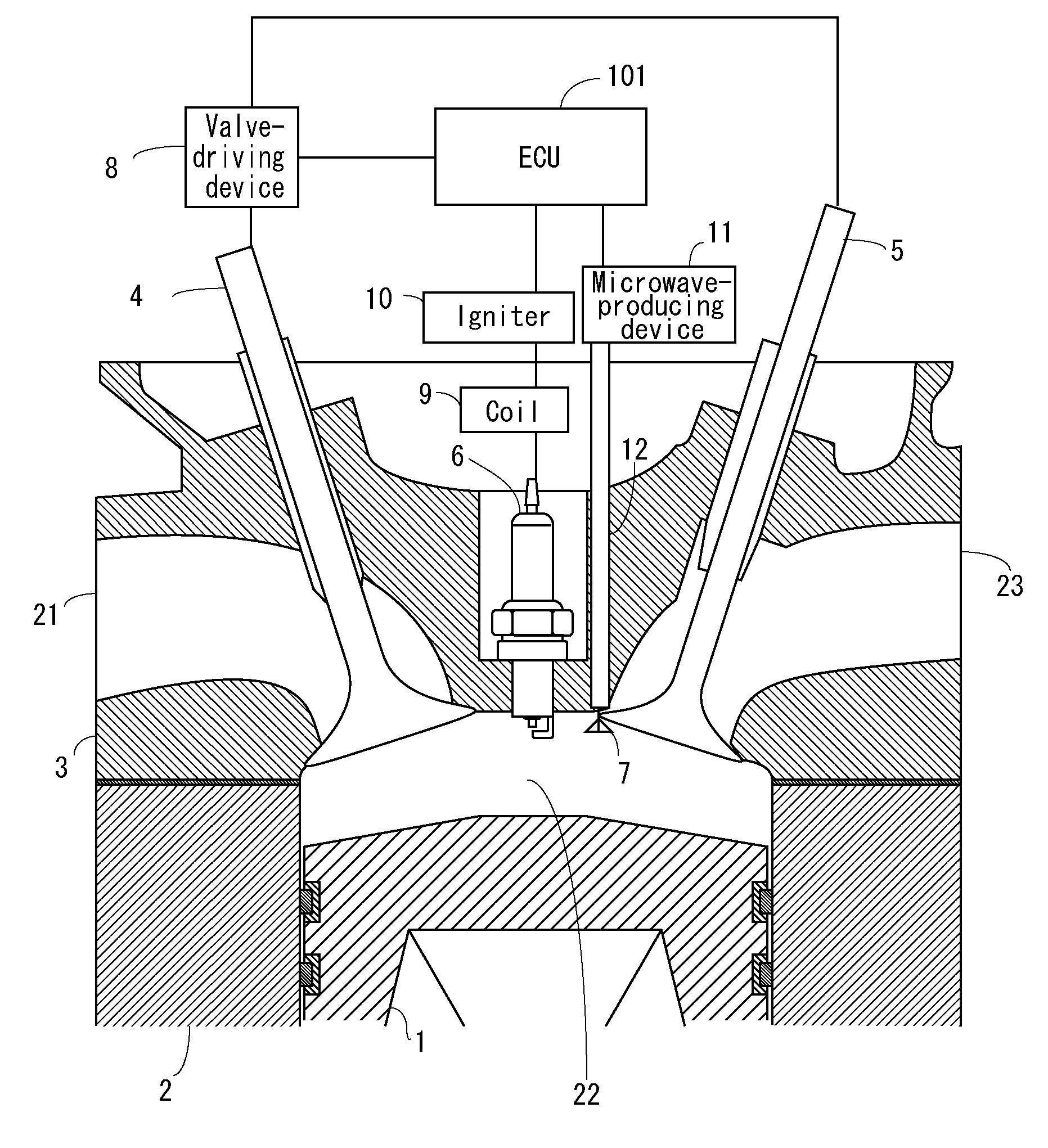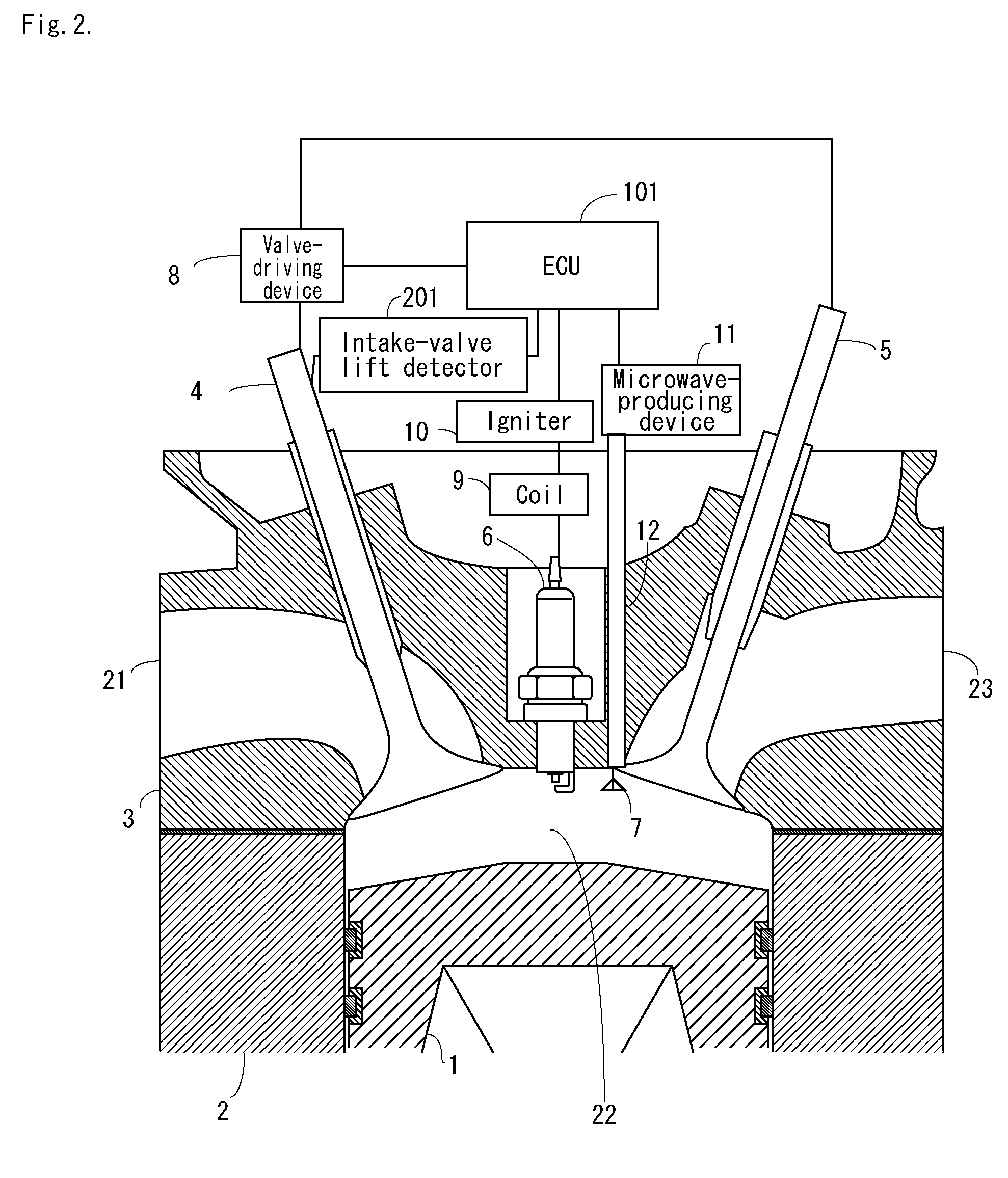Internal combustion engine using electromagnetic wave radiation to activate burnt gas
a technology of electromagnetic wave radiation and combustion engine, which is applied in the field of gas preparation, can solve the problems of affecting the effect of resource conservation, presenting safety problems, and enlarged installation space, and achieves the effects of facilitating resource conservation, facilitating resource conservation, and using safely
- Summary
- Abstract
- Description
- Claims
- Application Information
AI Technical Summary
Benefits of technology
Problems solved by technology
Method used
Image
Examples
first embodiment
[0035]FIG. 1 is a cross-sectional view that shows the configuration of an internal-combustion engine according to a first embodiment of the present invention.
[0036]The internal-combustion engine according to the first embodiment of the present invention has a combustion chamber 22 that is configured from a piston 1, a cylinder liner 2, and an engine head 3, as shown in FIG. 1.
[0037]A spark plug 6 for igniting the fuel mixture and an antenna 7 for generating plasma in the fuel mixture or in the burnt gas within the combustion chamber 22 are also provided to the combustion chamber 22.
[0038]In the combustion chamber 22, an intake valve 4 opens, whereby fresh gas is taken in, and an exhaust valve 5 opens, whereby burnt gas is discharged. The intake valve 4 and the exhaust valve 5 are opened and closed by a valve-driving device 8.
[0039]A constant spatial volume is maintained in the combustion chamber 22 even when the piston 1 is at top dead center, and therefore a portion of the burnt ga...
second embodiment
[0044]FIG. 2 is a cross-sectional view that shows the configuration of an internal-combustion engine according to a second embodiment of the present invention.
[0045]The internal-combustion engine according to the second embodiment of the present invention has an intake-valve lift detector 201, as shown in FIG. 2. The intake-valve lift detector 201 may be an eddy-current displacement gauge or a laser-Doppler displacement gauge. The intake-valve lift detector 201 detects the amount of lift (opening state) of the intake valve 4 and sends a detection signal to the control device (ECU) 101.
[0046]The antenna 7 generates microwaves timed after exhausting concludes and before intake begins, and activates the burnt gas remaining in the combustion chamber 22, a shown in FIG. 4.
[0047]The timing of the generation of microwaves is determined in the control device (ECU) 101 according to the output of the intake-valve lift detector 201. Control can thereby be prevented from deteriorating due to in...
third embodiment
[0048]FIG. 3 is a cross-sectional view that shows the configuration of an internal-combustion engine according to a third embodiment of the present invention.
[0049]The internal-combustion engine according to the third embodiment has an exhaust-gas recirculation mechanism, as shown in FIG. 3. This internal-combustion engine is such that so-called external exhaust gas recirculation; i.e., feeding back combustion exhaust gas toward an intake port 21, is used to reduce the combustion temperature. The combustion exhaust gas is fed back via an exhaust port 23 and through a conducting pipe 31 toward the intake port 21. The flow volume of the conducting pipe 31 is controlled by an on-off valve 32. The on-off valve 32 is controlled by the control device (ECU) 101.
[0050]The rest of the configurations are identical to the configuration of the first embodiment.
[0051]The concentration of burnt gas is high in this embodiment, and therefore plasma may also be generated even after intake commences....
PUM
 Login to View More
Login to View More Abstract
Description
Claims
Application Information
 Login to View More
Login to View More - R&D
- Intellectual Property
- Life Sciences
- Materials
- Tech Scout
- Unparalleled Data Quality
- Higher Quality Content
- 60% Fewer Hallucinations
Browse by: Latest US Patents, China's latest patents, Technical Efficacy Thesaurus, Application Domain, Technology Topic, Popular Technical Reports.
© 2025 PatSnap. All rights reserved.Legal|Privacy policy|Modern Slavery Act Transparency Statement|Sitemap|About US| Contact US: help@patsnap.com



